Give Rare Florida Native Plants a Lift
Jennifer Possley, M.S. GIS Lab Coordinator / Field Biologist
All photos by the author
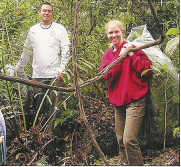 |
| Fairchild biologist Sam Wright and his wife Kam have removed invasive ferns while leaving the native ferns. |
Invasion by non-native plants is a constant threat to the survival of South Florida's native plants. While the majority of non-native plants grown in Florida are well-behaved, a few dropped out of charm school after the first day and have been terrorizing the natives ever since. Melaleuca (Melaleuca quinquenervia) and Brazilian pepper (Schinus terebinthifolius) are among the most infamous. (see Don Evans' article)
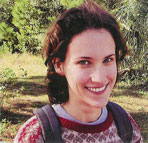 |
| Jennifer Possley |
Biologists Jennifer Possley of FTBG and Cristina Rodriguez of Miami-Dade County Natural Areas Management recently created a program to alleviate the pressure some of these invasive plants exert on Miami-Dade County's rarest plants. Jennifer, Cristina, and a small group of volunteers called the Rare Plant SWAT Team (So-long, Weeds and Trash) work at sites where herbicides cannot be used because invasive plants are intermixed with rare plants. Instead of using chemicals that could harm the rare plants as well as the invasive ones, they use brute force to remove these biological pollutants from native South Florida plant communities.
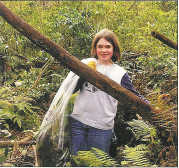 |
| Volunteer Gwen Mickish fills her bag with invasive plants and trash. |
The SWAT Team is currently targeting the invasive incised halberd fern (Tectaria incisa) in Bill Sadowski Park. This large, sometimes trunked, fern from Mexico and Central and South America is used in landscaping in South Florida. Unfortunately, its tiny spores can be blown by the wind to nearby natural areas, where they start new populations. In Bill Sadowski Park, the population probably established several decades ago, and hasn't been removed, due, in part, to the difficulty in identifying ferns. SWAT Team Volunteers work closely with Cristina and Jennifer to learn how to identify the target species and distinguish it from similar natives.
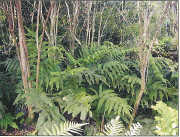 The hardwood hammock in Bill Sadowski Park before removal of Tectaria incisa.
The hardwood hammock in Bill Sadowski Park before removal of Tectaria incisa. |
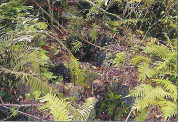 The same site after removal of T. incisa.
The convoluted limestone substrate (prime native fern habitat) is visible once more.
The same site after removal of T. incisa.
The convoluted limestone substrate (prime native fern habitat) is visible once more. |
As the SWAT team removes incised halberd ferns, native ferns such as the least and broad halberd ferns (Tectaria jimbriata, T. heracleifolia) and southern shield fern (Thelypteris kunthit) become visible. While the amount of native ferns in these newly uncovered areas is low compared to that of more pristine hammocks, the fact that these natives persist at all is great motivation to continue our work.
To date, the SWAT Team has spent five Saturday mornings on this project, removing approximately 170 garbage bags full of Tectaria incisa, and trash. This is not always easy work; thanks is owed to the Florida Native Plant Society (Dade Chapter) and Fairchild's Director of Volunteer Services, Arlene Ferris for helping to recruit such great volunteers!
Garden Views Summer 2004